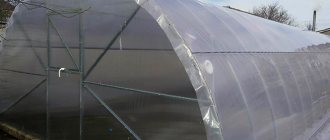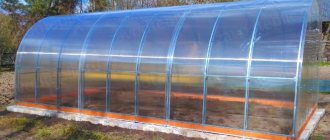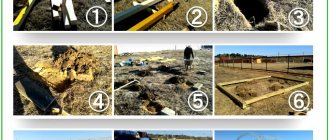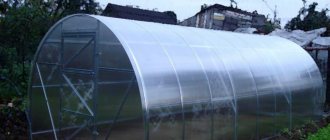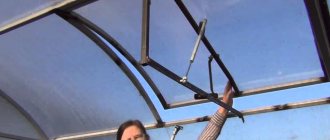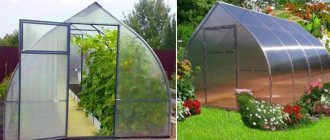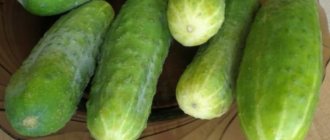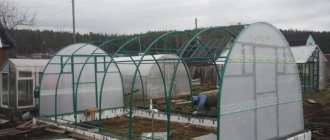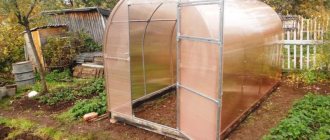Any personal plot is simply unthinkable without a good greenhouse. And if earlier this structure was made of wood and glass or plastic, now you can buy a ready-made, easily assembled version made of polycarbonate and metal. Such greenhouses are very convenient, perform their functions perfectly and look decent, and do not spoil the site at all. But, as with any other product, there are both good and far from the best quality options. For you - the top 10 best polycarbonate greenhouses, the ratings of which we present in this article.
A greenhouse at your summer cottage will always come in handy. It is ideal for the early cultivation of heat-loving crops, and in some cases will allow you to obtain crops throughout the year. But only a high-quality design will provide optimal conditions for growing plants and will serve for many years without complaints.
In this article we have collected the top 10 best greenhouses, which are preferred by many gardeners. The list is compiled based on their reviews and ratings. For ease of study, we divided it into two categories - arched and conical or lancet options.
Rating of the best greenhouses
| Photo | Name | Rating | Price | |||
| The best arched greenhouses | ||||||
| #1 | Volya Dacha Optima | ⭐ 4.95 / 5 2 - votes | More details | |||
| #2 | Bastion Premium | ⭐ 4.9 / 5 5 — votes | More details | |||
| #3 | Kremlin Suite | ⭐ 4.85 / 5 1 - voice | More details | |||
| #4 | Will Yota | ⭐ 4.8 / 5 1 - voice | More details | |||
| #5 | Uralochka | ⭐ 4.75 / 5 1 - voice | More details | |||
| The best cone greenhouses | ||||||
| #1 | Hacienda-4 Standard | ⭐ 4.95 / 5 2 - votes | More details | |||
| #2 | Orange Droplet | ⭐ 4.9 / 5 1 - voice | More details | |||
| #3 | Innovator Droplet | ⭐ 4.85 / 5 1 - voice | More details | |||
| #4 | Dachna Strelka | ⭐ 4.8 / 5 | More details | |||
| #5 | Kremlin Arrow | ⭐ 4.75 / 5 | More details | |||
Which greenhouse would you choose or recommend?
Take the survey
Buy or make it yourself?
If doing something yourself is not for you, then, of course, it is better to buy a factory version; ready-made greenhouses are widely available for sale.
But any gardener will tell you that, as a rule, store-bought greenhouses are not durable enough. The structure should be further strengthened and placed on a good foundation.
When constructing a greenhouse independently, each gardener tries to ensure a high margin of safety.
Sources
- https://topsov.com/rejting-teplic-iz-polikarbonata-dlja-dachi/
- https://stroyday.ru/stroitelstvo-doma/pridomovye-postrojki/rejting-teplic-iz-polikarbonata-top-10-populyarnyx-vybiraem-luchshuyu.html
- https://www.ivd.ru/stroitelstvo-i-remont/dacnyj-ucastok/kakaya-teplica-luchshe-vybiraem-po-3-parametram-76841
- https://vyborok.com/luchshie-teplitsyi-iz-polikarbonata-dlya-dachi/
- https://geostart.ru/post/1402
- https://krasnaja-polyana-ski.ru/ogorod/rejting-teplic-iz-polikarbonata.html
- https://tovar-otzyv.ru/obzor-7-mi-luchshih-teplicz-rejting-2019-2020-goda-po-otzyvam-polzovatelej/
- https://ProReyting.ru/oborudovanie/rejting-luchshih-teplits-iz-polikarbonata-top-7.html
- https://1PoMebeli.ru/rejtingi/rejting-luchshih-proizvoditelej-teplits.html
The best arched greenhouses
No. 1 – Volya Dacha Optima
Volya Dacha Optima
This greenhouse, according to most gardeners and experts, is recognized as one of the best on the market. Very durable, excellent for wintering on site and withstanding snow loads of up to 280 kg per square meter of surface, this design will last for many years without complaints. The frame is made of durable steel profile 6x2 cm, which does not rust thanks to the zinc coating. The height of the structure is 2.1 m, the width is 3 m, the length is different, and is presented in three variations for areas of different sizes. There are two doors for entry and a pair of vents for effective ventilation. The greenhouse is quite lightweight and does not require preliminary installation of a foundation. Thanks to detailed instructions and a lot of videos on the Internet, you can assemble it yourself. It is also noted that the cost of the product is very reasonable. The main disadvantage is that sometimes there are problems with the packaging; the manufacturer may forget to include part of the fasteners.
pros
- reliable design
- no foundation needed
- durable
- withstands heavy snow loads
- the frame does not rust
- nice price
Minuses
- there are problems with the configuration
No. 2 – Bastion Premium
Bastion Premium
One of the strongest and most durable greenhouses on the market. The design is made on the basis of double solid arches, providing it with the ability to withstand heavy snow loads of up to 1 ton. Arc welding is performed using the so-called plasma method. The arcs themselves are made of a pipe with a square cross-section and a thickness of 1.5 mm. The metal is protected from corrosion by powder paint and will last up to 25 years. This greenhouse is very easy to assemble - it only has 20 bolts. The kit includes pins that will allow you to secure the structure to the ground. You can assemble the product yourself within a couple of hours - it’s so simple. The main disadvantage is the difficulty of transportation due to large arcs. But the manufacturer gives a 10-year warranty on its product. Dimensions: width 3 m, height 2.1 m, length varies between 4-10 m.
pros
- very strong double frame
- no cracks after assembly
- corrosion protection
- excellent quality fittings
- quick assembly
Minuses
- difficulties in transportation
Video - Bastion Premium: review
No. 3 – Kremlin Suite
Kremlin Lux
This greenhouse is also loved by many for its strength, reliability and durability. It is very easy to assemble and the finished structure has no gaps through which cold air would penetrate inside. The greenhouse is based on a durable frame made of 2x2 cm profiled pipe; it has no reinforcements, but is very strong. Easy to assemble and disassemble, forming a level truss. The greenhouse can be installed either on a special foundation or on a soil foundation. The permissible snow load is 250 kg per square area.
The greenhouse is equipped with a pair of doors at the end parts, as well as two vents for ventilation. The model can additionally be equipped with automatic pushers for the vents, which will allow you not to worry about the fact that the greenhouse was not opened in time. But you will need to pay extra for this option. The main disadvantage of this greenhouse is its high cost.
pros
- reliable and durable design
- relatively light
- easy to assemble
- high quality frame
- powder coating of the frame
Minuses
- Expensive
Video - Assembling the Kremlevskaya greenhouse
No. 4 - Will Yota
Volya Yota
This greenhouse is the best value for money and is suitable for a small area. It is very durable - the frame is made of a zinc-coated pipe with a cross-section of 2x2 cm. The arcs are located at a distance of just over 1 m from each other. In short, everything is done to ensure that the greenhouse serves for a long time and can withstand significant loads - up to 560 kg per square of roof. The building has two end doors and two vents to provide ventilation. In addition, the manufacturer provides an 8-year warranty on its products.
pros
- very durable
- The optimum ratio of price and quality
- compact dimensions
- no need to clear snow in winter
Minuses
- narrow
Video – Review of the Iota greenhouse
No. 5 - Uralochka
Uralochka
Greenhouse made of polycarbonate, collecting a lot of positive reviews. It is light, compact, but suitable even for professional gardeners. The metal frame is represented by solid arcs with a cross-section of 3x2 cm, coated with primer-enamel. The model is easy to assemble and easily fixed on the ground. If necessary, you can install a special partition inside and divide the structure into two parts. Disadvantages - the profile of the arcs is too thin (only 1 mm), as well as the inability to withstand a large snow load - in winter the greenhouse must be constantly cleared of snow so that it does not collapse.
pros
- easy to use
- solid frame arches
- easy to assemble
- nice appearance
- light
Minuses
- the frame may rust
- In winter you need to remove snow from the roof
Video - Assembling the Uralochka greenhouse
Types of polycarbonate
Flexibility, light transmission, strength, aesthetics and light weight make polycarbonate an ideal material. However, there are a large number of its varieties, so choosing can be difficult. So, let’s find out which polycarbonate is better to choose for a greenhouse, according to reviews from gardeners.
- Monolithic. It is a polymer sheet, the thickness of which varies from 1 to 12 mm. Externally, it looks like plexiglass or acrylic glass. The sheets may have different colors or no color at all. The material is lightweight, resistant to shock, moisture and temperature changes. However, various acids leave stains on the surface, as summer residents warn about.
- Profiled. It has the properties of decorative and translucent fencing, thanks to which it is widely used in the construction of greenhouses and the creation of decor. Thin sheets up to 1.5 mm wide can withstand loads of more than 300 kg. According to reviews, the material is resistant to corrosion. When it rains, the sound of drops is not heard. This coating does not fade.
- Cell phone. Everyone decides for themselves which cellular polycarbonate is best for a greenhouse. According to reviews, the choice depends on the type of structure, weather conditions in the region, and the time of year during which the greenhouse will be outdoors. There are one-, two-, four- and six-chamber cellular polycarbonate. In each of them, the number of sheets and jumpers increases: if in the first case only 2 sheets and one row of jumpers are used, then in the latter there are 7 sheets and 6 rows of jumpers. This material has excellent thermal insulation properties, high frost resistance and impact resistance, but during installation it is necessary to use special fasteners. Cellular is the best polycarbonate for a greenhouse, reviews from gardeners confirm this.
The best cone greenhouses
No. 1 – Hacienda-4 Standard
Hacienda-4 Standard
Russian-made greenhouse with a durable galvanized frame. The cross-section of the pipes is 2.5x2.5 cm, and the thickness of the metal is 1.2 mm. The step between the solid arcs is small, only 65 cm, which suggests an increase in the strength of the product. And the polycarbonate with which the greenhouse is closed has a thickness of 4 mm, there are two options - standard and nano. The width of the structure will allow you to arrange three beds inside. The height is 2.3 m and is suitable for growing tall crops. The greenhouse is easy to assemble. It is suitable for those regions where snowfalls and strong winds are frequent.
pros
- very durable
- wide
- thick metal arcs
- solid arches
- optimal ratio of cost and quality
Minuses
- not detected
No. 2 – Orange Droplet
Orange Droplet
This droplet greenhouse is an excellent solution for growing tall crops. It has two variations, differing in width - 2.4 and 3 m. The frame has additional strength due to the presence of 8 stringers. In general, the greenhouse has two doors on the end sides and a pair of vents for ventilation. It is very durable and practical, has a simple design, is assembled fairly quickly and can last for a very long time. The only obvious drawback is the need to seal the gaps after assembly that form in the area of the doors and the ridge part.
pros
- very durable
- two width options
- nice appearance
- galvanized frame
- light
- nice price
Minuses
- additional sealing required
Video - Assembling the Orange Drop greenhouse
No. 3 – Innovator Droplet
Novator Droplet
Greenhouse, designed for installation in the northern regions. It is very durable and can easily withstand a large load of snow, which, however, almost does not linger on the roof due to its teardrop-shaped shape. The distance between the frame arcs is 66 cm. The frame itself is made of metal with corrosion protection, the profile has a cross-section of 2x2 cm. This greenhouse is very easy to assemble, since all its parts are informatively marked, and it is difficult to confuse them during installation. The manufacturer also provides a 10-year warranty on polycarbonate.
pros
- 10 years warranty
- durable and reliable
- anti-corrosion treatment
- roof vent and plastic barrel included
Minuses
- Expensive
No. 4 – Dachnaya Strelka
Dacha Strelka
A tall and comfortable greenhouse that rightfully occupies a leading position in various ratings. Its height is 2.4 m, and its pointed shape allows you to pay less attention to clearing snow from the roof in winter. And the frame itself is very durable and is designed for a snow load of up to 360 kg per square of roof. The width of the structure is 3 m and it is suitable for most areas. The greenhouse can be placed on a soil foundation without a foundation; it is fixed securely thanks to specially shaped pins. The frame can be disassembled, which allows the product to be transported even in a passenger car.
pros
- easy to transport
- durable and reliable
- installed without foundation
- high
- good ventilation
Minuses
- thin metal frame
Video - Assembling a greenhouse Dachnaya Strelka
No. 5 – Kremlin Strelka
Kremlin Strelka
Stable, durable and reliable greenhouse with a pointed roof. It is based on a metal frame made of a 2x2 cm profile and galvanized metal 1 mm thick. The height at the highest point of the roof is 2.45 m - the greenhouse is suitable for growing tall crops. Snow load is almost 300 kg per square meter. There are a pair of doors at the end and a pair of windows. The main disadvantage is the small width of 2.7 m, which is why it will not be possible to place many plants inside. In addition, among the disadvantages there is also a long and complex assembly. But the greenhouse will last for many years without complaints.
pros
- durable
- durable
- stainless steel frame
- high
Minuses
- difficulty of assembly
- narrow
By shape
Manufacturers offer greenhouses of various shapes, so summer residents have a legitimate question - what to choose. To make an effective decision, you should carefully study the features of the various options.
Arched or gable
The arched greenhouse reaches a height of no more than 2 meters, its length has no restrictions. The summer resident decides which sizes are suitable for his needs.
Arched greenhouse
Pros of the arch:
- ease of assembly, ability to carry out work independently;
- no need for a foundation;
- affordable cost of the finished structure;
- easy to disassemble, change the covering or move to another place;
- you can change the length of the structure without major alterations;
- high resistance to snow load.
Among the disadvantages are instability to gusts of wind and limited height.
Choosing a “house”, i.e. gable greenhouse, the summer resident receives:
- high variability of sizes (it is easy to create a structure of any height, width);
- wind resistance;
- the ability to do without a foundation;
- possibility of making vents on the roof.
Gable greenhouse
The high reliability of such greenhouses is guaranteed only if there is a foundation, which means that moving it will not be easy. It will require more material, thicker polycarbonate is needed for the coating.
Drop or arched
A cap of snow does not form on the droplet, but it has more modest dimensions, which are problematic to increase. Such a greenhouse is suitable only for the personal use of a small family. Compared to the arch, it has higher wind resistance.
Greenhouse droplet
How to choose the right greenhouse
A greenhouse is an excellent helper for any gardener. Thanks to it, you can get the first harvest of vegetables and herbs early enough, and if you have heating, you can generally grow plants all year round and always have vegetables from your own garden on the table. But to fully meet these expectations, it is very important to choose the right greenhouse. How to choose it correctly?
First of all, think about what functions it will perform and how it will be used. Some people plant plants in it only in the summer, while others need a product that allows them to grow vegetables all year round. Evaluate the structure itself: is there a need to disassemble it for the winter or is it easier to install a monolithic version. And, of course, it is important to decide what crops you plan to grow - at a minimum, decide whether these will be low-growing varieties or tall varieties.
Both its durability and the quality of plant life depend on how correctly the greenhouse is chosen.
Based on all this, you will have to choose a greenhouse, looking at its design features, dimensions, thickness of metal and polycarbonate and other factors.
Important! Take into account your region of residence. In areas where snowfalls are frequent and there are strong winds, you need to install a durable, or better yet, reinforced structure. Lightweight options will last at most 1-2 years in such conditions.
The material from which the greenhouse elements are made is also important. This is the frame and covering. Let's figure out what they are made of and which option would be preferable.
Covering material
The covering material protects the plants from rain and wind, and also helps retain solar heat inside the greenhouse, creating an optimal microclimate for growing. The classic option is regular polyethylene film (there is also reinforced film). This is a cheap material that retains heat well and allows the sun's rays to pass through. Installation is very simple and quick. However, the film is short-lived and breaks quickly - in a couple of years, at best, it will have to be completely replaced. Also, in some cases, when heated strongly, the film begins to release harmful substances into the atmosphere.
Previously, glass was also used, especially in industrial greenhouses. It is environmentally friendly, quite durable, and lasts longer than film. But glazing a greenhouse is not easy, and it is quite easy to break it.
Glass greenhouse
The optimal and modern solution is cellular polycarbonate, something between film and glass in its properties. This synthetic material can withstand fairly heavy loads, is durable and does not lose its properties for many years. The material is very simple to install, lightweight and relatively inexpensive. We recommend choosing polycarbonate.
On a note! Monolithic polycarbonate is also available for sale. This is not the best option for a greenhouse. It is heavy and does not retain heat well.
Cellular polycarbonate
If we talk about polycarbonate, it is important to choose its thickness correctly - the light transmittance and strength of the greenhouse depend on it. The best option is carbonate within 4-10 mm thickness. The thicker the sheet, the better the heat will be retained inside the greenhouse, and the stronger the greenhouse itself will be. And yes, be sure to take into account the presence of a UV-protective layer during installation - that side has a special marking. Without such a layer, polycarbonate quickly deteriorates.
What material should you not buy:
- with low density up to 0.65 kilograms per square meter;
- with a short warranty period;
- made from recycled materials.
A good polycarbonate sheet weighs between 7-10 kg, is made from primary raw materials, and is protected from UV rays.
Greenhouse frame
The second main element of the greenhouse is its frame. It can be created from plastic, aluminum or steel profile.
Table. Types of greenhouse frame.
| Type of material | Description |
| Plastic | This is the cheapest option. Plastic pipes are lightweight, easy to install, and do not rust. But a greenhouse based on them will not be durable and is unlikely to survive even the first winter if there is heavy snowfall. |
| Aluminum | Stainless steel frame, lightweight and easy to transport, quite easy to install. A fairly reliable option, but it is recommended to fix the arches in the foundation and remember that under heavy snow load it can bend and collapse. |
| Steel | Galvanized steel profile is the most durable and reliable option. Durable, does not rust if treated with anti-corrosion treatment, but is heavy. It is advisable to buy a greenhouse with solid arcs without welds. |
On a note! Previously, many people made a greenhouse based on a wooden frame. Nowadays such options are almost never found. Wood is a good material, but it rots quickly and, moreover, often becomes a breeding ground for parasites that destroy plants.
A metal frame is the most durable.
If we talk about a metal frame, then which option should you not buy:
- with metal that is too thin, less than 1 mm;
- with collapsible arches (depending on the region and climate);
- with a frame that requires more than 50 bolts to assemble;
- without anti-corrosion treatment;
- with very low weight.
What else needs to be considered
And finally, we’ll outline a few more points that need to be taken into account. So, a very important aspect is the shape of the greenhouse. This is especially important for regions where there is heavy snowfall in winter. Due to the heavy snow load, polycarbonate, and even the frame of the greenhouse, can easily break.
The traditional arched model of polycarbonate construction provides a lot of free space inside, but due to its fairly gentle slope, it requires regular cleaning of the roof in winter. The exception is very durable, reinforced greenhouses. An arched model, even the simplest one, is very wind-resistant.
Equal-wall structures with gable roofs also provide a lot of free space inside and can be very high. But they are usually difficult to install. As for the snow, it does not linger on such roofs, and this is already a big plus.
The third option is conical droplet greenhouses. They are optimal for those who grow tall plants. The snow comes off them without much difficulty on their own. But in most cases, this option requires additional sealing of the ridge part.
What else you need to look at:
- the distance between the arcs - the smaller it is, the stronger the greenhouse roof;
- presence of seals included;
- how many doors and windows are there;
- completeness of the set.
Construction stages
Before installing a greenhouse, it is necessary to study designs and structural drawings. This will create a strong structure. If you do the calculations yourself, seek help from professionals to make sure they are correct, and also decide which material to choose for the frame, which polycarbonate is better for the greenhouse (reviews of different types are presented in this article). The following stages of construction are distinguished:
- Choice of materials, sizes and shapes of the structure.
- Preparation of drawings.
- Carrying out the necessary work to strengthen the soil.
- Laying the foundation.
- Construction of load-bearing elements.
- Attaching the covering covering.
User voting
Which greenhouse would you choose or recommend?
Volya Dacha Optima
14.29 % ( 2 )
Bastion Premium
35.71 % ( 5 )
Kremlin Suite
7.14 % ( 1 )
Will Yota
7.14 % ( 1 )
Uralochka
7.14 % ( 1 )
Hacienda-4 Standard
14.29 % ( 2 )
Orange Droplet
7.14 % ( 1 )
Innovator Droplet
7.14 % ( 1 )
Dachna Strelka
0.00 % ( 0 )
Why is it needed?
Before studying the advantages and disadvantages of certain greenhouse models, determine the main purpose that the future shelter will serve:
- To expand the site and plant crops for home use: a simple design is suitable that will harmoniously fit into the overall appearance of the garden.
- For business and trade: there will be a more serious choice and large investments in the arrangement of the structure. After all, the scale of cultivation and profit depend on the size of the future greenhouse.
It is also worth deciding on the type of greenhouse structure - stationary or collapsible. The stationary modification is suitable for those who live in their country house almost all year round and are not afraid that in the absence of the owners, someone will be able to enter the site.
But collapsible models are ideal for “fickle” summer residents who come to the site and live there only during the warm summer period. Before leaving, the structure can be easily disassembled and transported for storage. The choice also depends on the type of crops that are planned to be grown there, because each variety has its own needs for humidity and light.
To grow tall plants, it is better to choose a rectangular greenhouse.
Once the key points on how to choose a greenhouse have been determined, we begin to consider other, but no less important, factors. Their combination will determine the ideal version of the future garden greenhouse.
Deciding on the sizes
When choosing a greenhouse for your garden plot, take into account the size of the structure. The optimal greenhouse width is 3-3.5 m (if you make it narrower, you will have to save on the number of beds). Any length can be provided - the most common is 5-6 m. It is not worth making a structure longer than 6 meters - it will become more difficult to care for the planted plants.
If the plot is large, then it is better to make 2-3 greenhouses of 5-6 m each than to build a huge structure of 15-18 m.
Consider the entrance doors too. They must be dense, close well and hermetically, and wide enough for passage (at least 1.2 m). After all, sometimes you need to bring gardening tools into the greenhouse on a cart.
Timber base for a garden greenhouse
A timber support is used when a greenhouse is urgently needed to grow a new crop that needs a separate comfortable place. This option helps to significantly save on building materials and is usually used for installing seasonal greenhouses.
Among the significant advantages of a timber foundation, experienced users name:
- quick installation and dismantling for moving the greenhouse to another location,
- smooth edges of the timber, allowing you to create a geometrically correct greenhouse frame,
- environmental cleanliness and safety of the material,
- creating a favorable microclimate for planted plants, thanks to good air permeability and heat retention,
- easy repairs in cases of rotting and damage by pests.
To increase the service life of the timber, you need to impregnate it with special antiseptics.
What is better: building a greenhouse on your own or buying a ready-made one?
Of course, anyone can build a greenhouse on their own, fortunately there are more than enough tutorials on the Internet today. However, as experience shows, in most cases the quality of such a design leaves much to be desired. The most common problems that self-taught builders face: skewed walls, leaking roofs, sinkholes, fragility of the structure in strong winds, etc.
Ready-made greenhouses, which can be delivered and assembled by professionals right on your site, do not have all these disadvantages. The main advantage of this solution is quality and reliability. When choosing a ready-made greenhouse, you can be sure that it will be strong, durable, assembled taking into account all the requirements of safety, functionality and aesthetics of the structure.
In principle, you can also assemble such a modular greenhouse on your own. Today, ready-made greenhouse structures and elements are sold in stores and construction markets. All you need is to assemble all the elements according to the instructions. It is not difficult to cope with this task - all elements are numbered, and the attached step-by-step instructions show in detail each stage of assembling the greenhouse.
Let's understand the package
What kind of greenhouse would you build?
With foundationWithout foundation
When choosing a ready-made greenhouse, take into account the proposed package, which includes doorways, vents and seals. Windows are needed in a greenhouse design; they help maintain a comfortable temperature in the summer heat, providing good ventilation. Seals provide the necessary tightness of joints and seams. This is very important for the winter period and maintaining a consistently warm temperature.
When purchasing a ready-made greenhouse, pay attention to the availability and detailed assembly instructions. If you see the word “economy” in the inscription, know that this greenhouse is suitable for use in the summer and has too wide a distance between the arcs.
